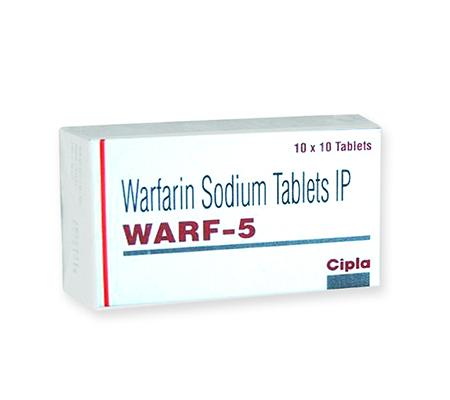Warf is used for treating and preventing harmful clots that may occur in the veins (venous thrombosis), in the lungs (pulmonary embolism), with a type of abnormal heartbeat (atrial fibrillation), or following a heart valve replacement. Warf is also used to reduce the risk of stroke and other problems in patients who have had a heart attack. Warf is an anticoagulant. It works by blocking the synthesis of certain clotting factors. Without these clotting factors, blood clots are unable to form.
Use Warf as directed by your doctor. Do not take in larger or smaller amounts or for longer than recommended. Follow the directions on your prescription label. Your doctor may occasionally change your dose to make sure you get the best results. Take Warf at the same time every day. Warf can be taken with or without food. Avoid dieting to lose weight while taking Warf. Tell your doctor if your body weight changes for any reason. While taking Warf, your blood will need to be tested often. Visit your doctor regularly.
You may need to stop taking the medicine for a short time if you need antibiotics, surgery, dental work, a spinal tap, or spinal anesthesia (epidural). Continue to take Warf even if you feel well. Do not miss any doses, unless directed to do so by your doctor. If you miss a dose of Warf, contact your doctor right away. Ask your health care provider any questions you may have about how to use Warf.
All medicines may cause side effects, but many people have no, or minor, side effects. No common side effects have been reported with Warf.
Seek medical attention right away if any of these severe side effects occur: severe allergic reactions (rash; hives; itching; difficulty breathing; tightness in the chest; swelling of the mouth, face, lips, or tongue); back, side, muscle, joint, or stomach pain; black, tarry, or bloody stools; blood in the urine (pink or brown urine); bloody or coffee ground-like vomit; chest pain; decreased urination; dizziness; fainting; fever; numbness or tingling; pain, unusual color, or temperature change in any area of the body; pale skin; purple, dark, or painful toes; shortness of breath; skin sores or ulcers; stroke symptoms (eg, confusion, slurred speech, vision problems, one-sided weakness); sudden severe pain in your legs, feet, or toes; trouble swallowing; unexplained swelling; unusual bruising or bleeding (eg, nosebleed, unusual bleeding from gums, increased bleeding from cuts, increased menstrual or vaginal bleeding, coughing up blood, bleeding at the injection site); unusual headache or weakness; unusual pain, swelling, or discomfort; wounds or sores that do not heal properly; yellowing of the skin or eyes.






